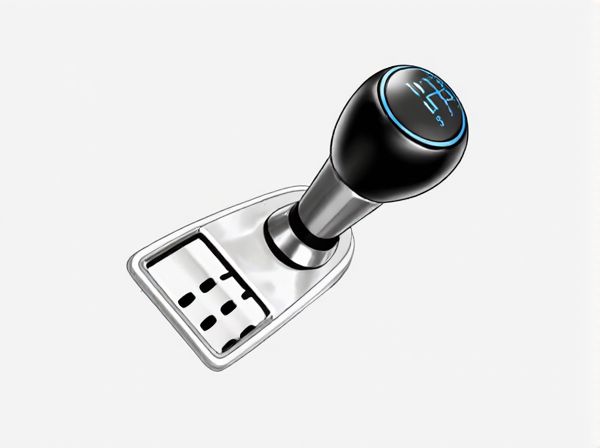
Photo illustration: Paddle-shift vs Stick-shift
Paddle-shift transmissions offer faster gear changes and allow you to keep both hands on the wheel, providing improved control and convenience during driving. Stick-shift transmissions deliver a more engaging driving experience with greater control over gear selection, appealing to enthusiasts who enjoy manual operation. Your choice depends on whether you prioritize ease and speed or driving involvement and skill development.
Table of Comparison
| Feature | Paddle-Shift Transmission | Stick-Shift Transmission |
|---|---|---|
| Control Type | Electronic paddle controls behind steering wheel | Manual gear lever operated by hand |
| Shift Speed | Faster, near-instant gear changes | Slower, depends on driver skill |
| Ease of Use | Easy, minimal learning curve | Challenging, requires coordination and practice |
| Driver Involvement | Moderate, automated with manual override | High, full manual control over gear selection |
| Fuel Efficiency | Improved due to optimized shifting algorithms | Depends on driver technique |
| Common Usage | Sports cars, modern automatics, performance vehicles | Sports cars, economy cars, driving enthusiasts |
| Maintenance | Low, electronic components may require updates | Higher, clutch and transmission wear |
Introduction to Paddle-shift and Stick-shift
Paddle-shift transmissions utilize electronic controls that allow drivers to change gears with paddles mounted on the steering wheel, offering quicker and more precise gear shifts compared to traditional manual systems. Stick-shift, or manual transmissions, require the driver to engage a clutch pedal and manually move a gear stick to select gears, providing a more hands-on driving experience and greater control over the vehicle's power delivery. Paddle-shifts are commonly found in modern sports and luxury cars, while stick-shifts remain popular among driving enthusiasts who prefer direct mechanical engagement.
How Paddle-shift Transmissions Work
Paddle-shift transmissions operate using electronic sensors and hydraulic or electronic actuators to change gears without a clutch pedal, allowing drivers to manually shift through gears via paddles mounted behind the steering wheel. These systems receive input from the driver's paddle commands and then electronically control the transmission's gear selection, delivering faster and smoother shifts compared to traditional stick-shift manual transmissions. Paddle-shift transmissions enhance driving convenience and performance by combining automatic transmission ease with manual gear control precision.
Understanding Traditional Stick-shift Mechanisms
Traditional stick-shift mechanisms operate through a manual transmission system that relies on a clutch pedal and gear stick to manually engage and disengage gears, providing precise control over vehicle acceleration and engine power. The driver must coordinate clutch release and gear selection to match engine speed, enhancing fuel efficiency and driving skill mastery. Unlike paddle-shifts, which automate gear changes via electronic controls, stick-shift systems emphasize mechanical linkage and driver input for gear engagement.
Performance Comparison: Paddle-shift vs Stick-shift
Paddle-shift transmissions deliver faster and more precise gear changes by utilizing electronic actuators compared to the mechanical linkage of stick-shifts, resulting in improved acceleration times and smoother performance. Stick-shift systems provide direct driver engagement and better control over engine power, which can optimize fuel efficiency and customize driving dynamics in skilled hands. High-performance vehicles often favor paddle-shifts for rapid shift response in competitive settings, while manual stick-shifts remain preferred for enthusiasts seeking tactile feedback and driving involvement.
Driving Experience and Engagement
Paddle-shift transmissions offer rapid gear changes with minimal driver effort, enhancing convenience and maintaining focus on steering, ideal for performance-oriented driving. Stick-shift controls require deliberate clutch engagement and manual gear selection, providing a tactile connection and greater driver involvement, which many enthusiasts find more engaging. The choice between paddle-shift and stick-shift significantly influences driving dynamics, with paddle-shifts favoring speed and ease, while stick-shifts emphasize skill and driver engagement.
Fuel Efficiency: Which Shifter Performs Better?
Paddle-shift transmissions generally provide better fuel efficiency compared to stick-shift systems by optimizing gear changes through electronic controls that reduce engine load. Manual stick-shift cars rely heavily on driver skill for efficient fuel use, often resulting in inconsistent fuel economy. Studies show vehicles equipped with paddle shifters can achieve up to 5-10% improved fuel savings due to faster and more precise gear shifts.
Maintenance and Longevity Considerations
Paddle-shift transmissions typically require less frequent clutch and gearbox maintenance due to their automated electronic controls, leading to enhanced durability and longer service intervals compared to traditional stick-shift systems. Stick-shift vehicles often demand regular clutch replacements and more frequent adjustments to the transmission linkage, which can increase maintenance costs and affect overall longevity. Choosing between paddle-shift and stick-shift transmissions depends on balancing maintenance convenience with driving engagement preferences.
Cost Differences: Purchase and Repairs
Paddle-shift vehicles typically have higher initial purchase costs due to advanced electronic systems and dual-clutch transmissions, while stick-shift cars are generally more affordable to buy, appealing to budget-conscious drivers. Repair and maintenance expenses for paddle-shift transmissions can be significantly more expensive given the complexity of electronic controls and specialized parts compared to the simpler mechanical components in manual stick-shift transmissions. Stick-shift repairs are often less costly and more straightforward, making them a cost-effective choice for long-term ownership and maintenance.
Suitability for Daily Driving and Motorsports
Paddle-shift transmissions offer seamless gear changes and quicker response times, making them highly suitable for daily commuting and competitive motorsports where precision and speed are critical. Stick-shift, or manual transmissions, provide greater driver engagement and control, preferred by enthusiasts in motorsports for tactical gear selection but can be less convenient in stop-and-go urban traffic. For daily driving, paddle-shifts reduce driver fatigue and simplify operation, while stick-shifts may enhance the driving experience but require more skill and attention.
Future Trends in Transmission Technology
Paddle-shift transmissions are increasingly favored in modern vehicles due to their seamless gear changes and integration with advanced driver-assistance systems, supporting the shift toward electric and hybrid drivetrains. Stick-shift transmissions, while preferred by driving enthusiasts for manual control and engagement, are becoming less common as automated systems offer improved efficiency and reduced emissions. Future transmission technology trends emphasize enhanced automation, adaptive shifting algorithms, and compatibility with electrified vehicles, driving the gradual decline of traditional manual gearboxes.
 caratoz.com
caratoz.com